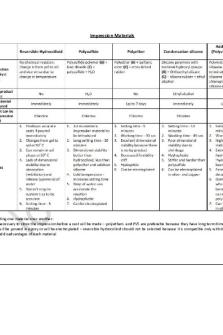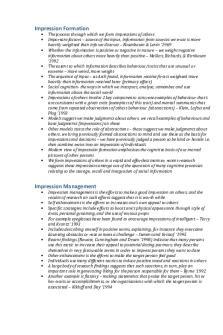Impression Management Notes PDF

| Title | Impression Management Notes |
|---|---|
| Course | Sociology 1A: Self and Society |
| Institution | University of Glasgow |
| Pages | 3 |
| File Size | 48.6 KB |
| File Type | |
| Total Downloads | 75 |
| Total Views | 125 |
Summary
Summary of impression management theory and related criticism....
Description
In his book ‘The Presentation of Self in Everyday Life’, Goffman puts forward his theory of impression management, which is that the self in a performed character, and that we control and organise the impression we give others. Goffman analyses interpersonal interaction and how individuals ‘perform’ in order to project a desirable image, using the dramaturgical metaphor to illustrate individuals’ contrasting front stage and back stage behaviour. During interaction, those participating are viewed as actors. When in front stage, an actor is conscious of being observed by an audience and will perform to those watching by observing certain rules and social conventions, as failing to do so means losing face and failing to project the image and persona they wish to create. The actor’s behaviour will be different in a private, back- stage environment, however, as no performance is necessary. One motive for ‘performing’ in a certain way is that it presents a positive view of ourselves to the world, and helps us conform in society. One of Goffman’s key arguments is that individuals have both impressions that they give and those that they give off. The first describes impressions that the individual intends to produce are communicate, while the other describes impressions that were not intended to be given are received by the audience. In addition to the impressions we give and give off, Goffman also considered more-established metaphors such as the mask as a means for deception in face-to-face interaction. Because ‘a mask of manner can be held in place from within’, an individual can bring forth certain aspects of themselves in the interaction while simultaneously marginalising others. The individual is not ‘becoming somebody else’ when they does this, but rather, both the mask worn and the hidden person behind it are facets of the same individual. One reason for doing this is that it allows us as individuals to achieve personal goals. Hochschild wrote a book in 1979, part of in which she criticises Goffman’s theory. One criticism is that a focus on everyday interaction between individuals arguably underplays the extent to which social relations are shaped by wider structures in society, such as social class. In addition, the
emphasis on interactions as a performance seem to suggest that there is no true sense of inner self that exists beyond the roles in which an individual plays, which is a bold claim to make and is not easily accepted by the majority of people. Finally, the dramaturgical metaphor may work well for Western societies such as the US and the UK, however it is far less applicable in societies where there is not such a marked division between public and private spheres. Goffman’s theories are still relevant today. For example, in Bullingham’s ‘“The presentation of self in the online world,” he explores the proposal that online environments provide their users with the potential to perform and present different identities. In Goffman’s terms, offline would be the ‘backstage,’ while online would be ‘front-stage’ in which an individual would ‘perform’ to the audience of other online users. An example of this can be seen in virtual reality. Users create avatars, the appearance of which they can choose and alter, and with these avatars they can create their selfrepresentations, choosing what to bring to the foreground or hide in the background. In his paper, Bullingham conducts case studies and interviews with virtual reality users. One participant explains that they present their online self as more creative through dressing their avatar in extravagant clothing, while in reality, offline they dress formally and conservatively. This is a direct example of Goffman’s impression management, as the actor attempts to control how they are presented to the audience. Users can also have multiple avatars, with certain aspects of self, such as appearance or behaviour. This use of multiple alternative avatars is arguably a manifestation of Goffman’s claim that we adopt multiple roles and multiple identities in our everyday life. The study also noted that users across various virtual worlds aim for the Western concept of beauty, and that older or overweight users especially create leaner, younger, versions of themselves. These findings showcase how society shapes our sense of self as well as our presentation of it– society deems certain qualities as appealing, and individuals therefore strive for these qualities to be accepted by society. The various cases explored here demonstrate that Goffman’s original framework is not only still
applicable, but also of great usefulness as an explanatory framework for understanding identity through interaction and presentation of self in the online world....
Similar Free PDFs

Impression Management Notes
- 3 Pages

Impression Materials
- 2 Pages

First impression
- 9 Pages

Memoire bon impression
- 47 Pages

FIS 205 Impression Evidence
- 9 Pages

Chapter 22 Impression Evidence
- 4 Pages

Management Notes
- 28 Pages

Management general notes
- 48 Pages

Management Consulting Lecture Notes
- 14 Pages
Popular Institutions
- Tinajero National High School - Annex
- Politeknik Caltex Riau
- Yokohama City University
- SGT University
- University of Al-Qadisiyah
- Divine Word College of Vigan
- Techniek College Rotterdam
- Universidade de Santiago
- Universiti Teknologi MARA Cawangan Johor Kampus Pasir Gudang
- Poltekkes Kemenkes Yogyakarta
- Baguio City National High School
- Colegio san marcos
- preparatoria uno
- Centro de Bachillerato Tecnológico Industrial y de Servicios No. 107
- Dalian Maritime University
- Quang Trung Secondary School
- Colegio Tecnológico en Informática
- Corporación Regional de Educación Superior
- Grupo CEDVA
- Dar Al Uloom University
- Centro de Estudios Preuniversitarios de la Universidad Nacional de Ingeniería
- 上智大学
- Aakash International School, Nuna Majara
- San Felipe Neri Catholic School
- Kang Chiao International School - New Taipei City
- Misamis Occidental National High School
- Institución Educativa Escuela Normal Juan Ladrilleros
- Kolehiyo ng Pantukan
- Batanes State College
- Instituto Continental
- Sekolah Menengah Kejuruan Kesehatan Kaltara (Tarakan)
- Colegio de La Inmaculada Concepcion - Cebu






